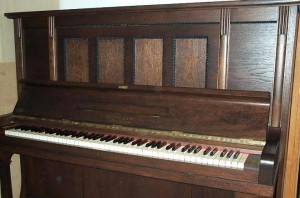Katie Hammonds’ Waltz-The Song That Didn’t Die
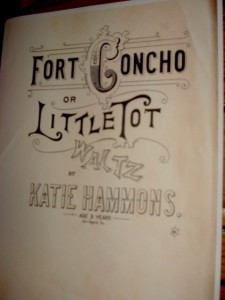
Last night I woke from a dream with a piano tinkling a waltz somewhere in the house, still seeing the dancers whirling behind my eyes, the ladies’ skirts flaring as they turned.
And I knew Katie Hammonds had been here.
It wasn’t the first time.
This all started in October, 2012, when I flew to San Angelo, Texas for a writers’ conference at Stephens Central Library.
I flew in on the puddle-jumper and saw a country with more land than people, flat, dusty, dotted with mesquite trees and, improbably, crossed by the Concho– a skinny river running through scrubby banks and occasional cottonwood.

Beauregard Avenue Bridge over the Concho River.
I had no transportation, couldn’t afford it, so one of the lovely library people gave me a ride to my bed and breakfast.
I didn’t like the B&B. The only lullaby was traffic. It was crowded with so much furniture I had to weave through the room. Doodads covered every surface and potpourri penetrated every crack.

Could pass for my B&B
A soundtrack featuring harps drove me crazy.
Nope, I thought, and turned to tell the hostess I was moving on.
Then I saw a piano, and the sheet music sitting in the rack was so old the parchment was yellow.
I wandered over to the piano and saw “Fort Concho or Little Tot Waltz By Katie Hammons. Age 9 years. San Angelo, Tex.” Inside, it said, “Copyright, 1888, by E.W. Hammons.”
I played the piece. The waltz was written in b flat, and its tempo was allegro. It was simple and plaintive, evoking couples gliding on hardwood floors, candles fluttering, men and boys holding their partners oh so carefully.

Just discovering the music made me change my mind about the B&B. I felt like someone was telling me to stay: So I did, and got used to the smell of potpourri.
I badly wanted a copy of Katie Hammonds’ music, but the B&B owner did not give me permission to take the waltz to a copy shop.
But I had a feeling.

Parade passes the Tom Green County Courthouse on Sept. 17, 1888, celebrating the arrival of San Angelo’s first train.
I went to the West Texas Collection Archives at Angelo State University to research and the first thing I did was ask about Katie.
To my joy and amazement, they had an original Little Tot Waltz and gave me a copy! That made my week.
The collection also contained several undated newspaper stories about the Hammons’ family.

The Gulf, Colorado and Santa Fe Railroad built this depot in San Angelo in 1888.
E.W. (Elijah Watkins) Hammons, Katie’s father, was a traveling piano salesman and owned shares in the local Artesian Well Company.
E.W. also sold pianos in San Angelo and the nearby towns of Abilene and Ballenger.
The newspaper actually noted what dates E.W. traveled to other towns.
E.W. must have done well. He bought a house and two lots in the “Miles Addition” for $225.
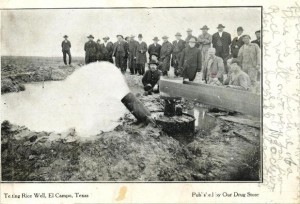
Testing an artesian well in El Campo, Texas
We know Katie had a B average in fourth grade, and no wonder. School principal H.V. Moulton bragged, to the paper, the grammar school had “A fine globe, fine sets of maps and charts, and our school board has ordered a set of philosophical apparatus.”
One more thing. The family eventually moved to Waco. Drat.
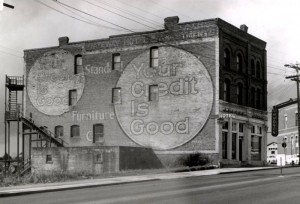
What happened to Katie? Did she die from some dread disease and was photographed in her coffin, as was often done in the 19th Century?
This could have been an eternal mystery, but I know so much, thanks to the kind folks at Waco Historical Society.
The Hammons lived in Waco one year then moved to Tarrant County (Fort Worth), where the family was listed on the 1920 census.
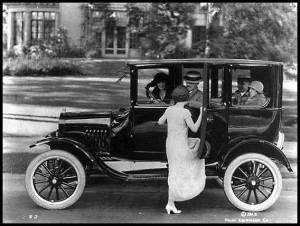
In 1930, the family lived in Dallas, on Roseland Street.
In the 30s, Katie, and her father and mother, Dorinda, lived in the same house on Roseland, as did sisters Dora, Ray and Rilla, as did Rilla’s husband and three little boys.
In 1930, Katie, 43-years-old, was an organ teacher.

E.W. died on June 30, 1934, of heart disease, and her mother died in 1941, both still living on Roseland Street.
Katherine Nanette Hammons died Aug. 21, 1962, of colon cancer. She was 83.
Both Katie and E.W. are buried at Restland Memorial Park, in Dallas.

There you go, two quiet lives.
We have no evidence, but I believe they were a happy father and daughter.
E.W. was musical, Katie was musical, and they lived together all their lives.
How he loved her. He was so proud of his nine-year-old that he published her music.
Katie, I played your waltz today and you seemed so close, as if you stood right by the piano.
The post Katie Hammonds’ Waltz-The Song That Didn’t Die appeared first on Julia Robb, Novelist.
Published on July 26, 2014 21:16
No comments have been added yet.

